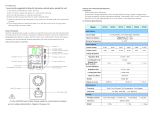ESAB EDW 610D is a combined engine driven welding and electric power unit, suitable for MMA welding with all types of DC electrodes, especially cellulose; scratch start TIG welding or TIG with additional equipment for high frequency start and for arc air gouging. The auxiliary power generator provides alternating current for power tools, lighting etc. Continuous welding and auxiliary power can be used simultaneously.
The ESAB EDW 610D is ideal for quality welding in assembly work, service and repair in the field, e.g. pipelines, petrol-chemical plants, off-shore work etc.
Key capabilities include:
ESAB EDW 610D is a combined engine driven welding and electric power unit, suitable for MMA welding with all types of DC electrodes, especially cellulose; scratch start TIG welding or TIG with additional equipment for high frequency start and for arc air gouging. The auxiliary power generator provides alternating current for power tools, lighting etc. Continuous welding and auxiliary power can be used simultaneously.
The ESAB EDW 610D is ideal for quality welding in assembly work, service and repair in the field, e.g. pipelines, petrol-chemical plants, off-shore work etc.
Key capabilities include:



















-
 1
1
-
 2
2
-
 3
3
-
 4
4
-
 5
5
-
 6
6
-
 7
7
-
 8
8
-
 9
9
-
 10
10
-
 11
11
-
 12
12
-
 13
13
-
 14
14
-
 15
15
-
 16
16
-
 17
17
-
 18
18
-
 19
19
ESAB EDW 610D is a combined engine driven welding and electric power unit, suitable for MMA welding with all types of DC electrodes, especially cellulose; scratch start TIG welding or TIG with additional equipment for high frequency start and for arc air gouging. The auxiliary power generator provides alternating current for power tools, lighting etc. Continuous welding and auxiliary power can be used simultaneously.
The ESAB EDW 610D is ideal for quality welding in assembly work, service and repair in the field, e.g. pipelines, petrol-chemical plants, off-shore work etc.
Key capabilities include:
Ask a question and I''ll find the answer in the document
Finding information in a document is now easier with AI
Related papers
-
ESAB Origo™ Arc 250 User manual
-
ESAB ESABArc 400 User manual
-
ESAB A6 CRE 30 / A6 CRE 60 User manual
-
ESAB Mig 630tw Magma User manual
-
ESAB Mag C251 - Origo™ User manual
-
ESAB Mig L305 User manual
-
ESAB Mig 410 Mig 510 Origo™ User manual
-
ESAB Mig 500t User manual
-
ESAB Tig 3001i, Tig 3001iw User manual
-
ESAB Mig 630tw Magma User manual
Other documents
-
Miller BIG BLUE 600 X (DEUTZ) Owner's manual
-
Miller Electric BIG BLUE 600 X (DEUTZ) User manual
-
Precision GTX 36 User manual
-
 Navitech NP3010 User manual
Navitech NP3010 User manual
-
Miller LG300055E Owner's manual
-
Miller Big Blue 400 CX CE Owner's manual
-
Miller LF350569 Owner's manual
-
Miller MB270021E Owner's manual
-
Miller LH900057E Owner's manual
-
Miller LH030117E Owner's manual



















